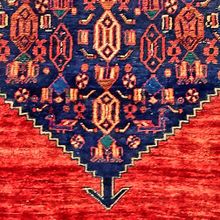Difference between revisions of "Songhor Rug"
| Line 35: | Line 35: | ||
|additional info = | |additional info = | ||
}} | }} | ||
| − | + | Songhore is a small village in western Iran at the heart of Kurdistan. The region sits high on the rugged mountains of Persia and life here can be very harsh. The semi-nomadic tribes men and women who weave these rugs, do so in an attempt to follow a tradition of textile art that has been part of their culture for thousands of years. The rugs made in and around Songhore all have similarities in design and quality to most other Kurdish rugs. The colors are bright yet earthy, and the designs are simple and geometric, yet fun and exciting. The quality in these rugs is fairly good and the sizes are usually around five by eight feet. The main colors include taupe, camel, red, and navy blue. These rugs are very special to their weavers and they always bring a special warmth to their new homes. | |
| − | Songhore is a small village in western Iran at the heart of Kurdistan. The region sits high on the rugged mountains of Persia and life here can be very harsh. The semi-nomadic tribes men and women who weave these rugs, do so in an attempt to follow a tradition of textile art that has been part of their culture for thousands of years. The rugs made in and around Songhore all have similarities in design and quality to most other Kurdish rugs. The colors are bright yet earthy, and the designs are simple and geometric, yet fun and exciting. The quality in these rugs is fairly good and the sizes are usually around five by eight feet. The main colors include taupe, camel, red, and navy blue. These rugs are very special to their weavers and they always bring a special warmth to their new homes. | ||
| − | |||
<!-- from Rugman Archive:https://web.archive.org/web/20040612190509/http://www.rugman.com:80/Library/RugStyle/Songhore_rugs.htm --> | <!-- from Rugman Archive:https://web.archive.org/web/20040612190509/http://www.rugman.com:80/Library/RugStyle/Songhore_rugs.htm --> | ||
| − | + | == History == | |
| + | == Materials == | ||
| + | === Foundation and Pile === | ||
| + | == Techniques and structures == | ||
| + | === Color and dyeing === | ||
| + | === Motifs and Designs === | ||
| + | === Weaving techniques === | ||
| + | == See also == | ||
| + | == References == | ||
| + | {{Reflist}} | ||
| + | == Bibliography == | ||
| + | Abraham Levi Moheban, (2015), ''[[The Encyclopedia of Antique Carpets|The Encyclopedia of Antique Carpets: Twenty-Five Centuries of Weaving]]'', NewYork: Princeton Architectural Press. | ||
[[Category:Persian Rug and Carpet]] | [[Category:Persian Rug and Carpet]] | ||
[[Category:Rug and Carpet]] | [[Category:Rug and Carpet]] | ||
[[fa:قالی_سنقر]] | [[fa:قالی_سنقر]] | ||
Revision as of 09:30, 4 December 2019
| Songhor Rug | |
|---|---|
 Design of Sonqor Rug (Rugman) | |
| General information | |
| Name | Sonqor Rug |
| Original name | قالی سنقر |
| Alternative name(s) | Sonqor Carpet |
| Origin | |
| Category | Village |
| Technical information | |
| Common designs | Geometric |
| Common colors | Red, Blue, Camel, Gray |
| Dyeing method | Natural, Synthetic |
| Pile material | Wool |
| Foundation material | Cotton |
| Knot type | Symmetrical (Turkish) |
Songhore is a small village in western Iran at the heart of Kurdistan. The region sits high on the rugged mountains of Persia and life here can be very harsh. The semi-nomadic tribes men and women who weave these rugs, do so in an attempt to follow a tradition of textile art that has been part of their culture for thousands of years. The rugs made in and around Songhore all have similarities in design and quality to most other Kurdish rugs. The colors are bright yet earthy, and the designs are simple and geometric, yet fun and exciting. The quality in these rugs is fairly good and the sizes are usually around five by eight feet. The main colors include taupe, camel, red, and navy blue. These rugs are very special to their weavers and they always bring a special warmth to their new homes.
History
Materials
Foundation and Pile
Techniques and structures
Color and dyeing
Motifs and Designs
Weaving techniques
See also
References
Bibliography
Abraham Levi Moheban, (2015), The Encyclopedia of Antique Carpets: Twenty-Five Centuries of Weaving, NewYork: Princeton Architectural Press.